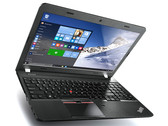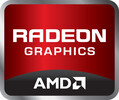AMD Radeon R7 M370 The AMD Radeon R7 M370 is a lower mid-range graphics card for laptops that was announced mid 2015. It is based on the 28nm Mars chip that uses the GCN (Graphics Core Next) architecture. Therefore, it is similar to the older Radeon R9 M260X but slightly lower clocked.
Performance
Thanks to its relatively high memory bandwidth, the performance of the Radeon R7 M370 is similar to the Nvidia GeForce 830M . Current and demanding games of 2015 will run fluently only low or medium resolutions and detail settings. In older games, however, higher quality settings will be possible.
The 384 shaders can be used with OpenCL 1.2 for general-purpose calculations (as 6 compute units). Compared to old TeraScale 2 chips, the GCN-based Mars architecture offers improved performance in this framework.
Features
Features of the R7 M370 include video decoding for MPEG-4 AVC/H.264, VC-1, MPEG-2, and Flash directly by the AMD GPU. Multi-View Codec (MVC) and MPEG-4 part 2 (DivX, xVid) HD videos are compatible as well.
The R7 series also supports automatic graphics switching between the integrated GPU and discrete GPU. Called Enduro , the technology supersedes AMD's Dynamic Switchable Graphics and is similar to Nvidia's Optimus. Furthermore, the M265 can directly support multiple monitors using Eyefinity Technology if Enduro is disabled.
Other features include ZeroCore for reducing power consumption when the display is turned off and Power Gating to power down areas of the chip that are not used. PowerTune allows automatic overclocking and underclocking of the graphics card as long as the GPU is within its TDP limit. For example, the chip may be underclocked when running FurMark and OCCT, but will overclock in certain games like Lost Planet, Crysis or Resident Evil 5.
The integrated HD audio processor is able to transmit HD Audio (TrueHD or DTS Master Audio) over HDMI and DisplayPort (e.g., for Blu-Ray videos). Additionally, it allows audio output simultaneously and in parallel to multiple devices with the new Discrete Digital Multipoint Audio (DDMA) feature.
Power consumption
The power consumption should be similar to the old Radeon HD 8670M and slightly above the Maxwell-based Nvidia GeForce 830M . As a result, the R7 M370 is best suited for 13-inch notebooks or larger.
Radeon R7 M300 Series Architecture GCN Pipelines 384 - unified Core Speed 875 MHz Memory Speed 3600 MHz Memory Bus Width 128 Bit Memory Type GDDR5 Max. Amount of Memory 2048 MB Shared Memory no API DirectX 12, Shader 5.0, OpenGL 4.4 Transistor Count 1 Billion technology 28 nm Features Mantle, PCIe 3.0, Zero Core, PowerTune Notebook Size medium sized Date of Announcement 06.05.2015
Benchmarks Performance Rating - 3DMark 11 + Fire Strike + Time Spy
3DMark - 3DMark Fire Strike Standard Score
min: 1609 avg: 1659 median: 1654 (2%) max: 1714 Points
3DMark - 3DMark Fire Strike Standard Graphics
min: 1693 avg: 1751 median: 1760 (2%) max: 1801 Points
3DMark - 3DMark Ice Storm Graphics
min: 34077 avg: 44852 median: 34092 (4%) max: 66387 Points
3DMark - 3DMark Ice Storm Unlimited Graphics
3DMark - 3DMark Ice Storm Extreme Graphics
3DMark - 3DMark Cloud Gate Score
min: 7083 avg: 7881 median: 7169 (7%) max: 9391 Points
3DMark - 3DMark Cloud Gate Graphics
min: 10288 avg: 11149 median: 10364 (3%) max: 12795 Points
3DMark 11 - 3DM11 Performance Score
min: 2689 avg: 2802 median: 2690 (3%) max: 3027 Points
3DMark 11 - 3DM11 Performance GPU
min: 2522 avg: 2595 median: 2524 (2%) max: 2739 Points
3DMark Vantage + 3DMark Vantage - 3DM Vant. Perf. total
3DM Vant. Perf. GPU no PhysX + 3DMark Vantage - 3DM Vant. Perf. GPU no PhysX
3DMark 06 3DMark 06 - Standard 1280x1024 + SPECviewperf 11 + SPECviewperf 11 - specvp11 snx-01
min: 7.8 avg: 8.3 median: 8.3 (5%) max: 8.7 fps
specvp11 tcvis-02 + SPECviewperf 11 - specvp11 tcvis-02
min: 2.95 avg: 5.1 median: 5.1 (3%) max: 7.34 fps
specvp11 sw-02 + SPECviewperf 11 - specvp11 sw-02
min: 12.08 avg: 18.9 median: 18.9 (14%) max: 25.7 fps
specvp11 proe-05 + SPECviewperf 11 - specvp11 proe-05
min: 3.21 avg: 3.8 median: 3.8 (5%) max: 4.48 fps
specvp11 maya-03 + SPECviewperf 11 - specvp11 maya-03
min: 6.67 avg: 10 median: 10 (8%) max: 13.33 fps
specvp11 lightwave-01 + SPECviewperf 11 - specvp11 lightwave-01
min: 14.55 avg: 20.6 median: 20.6 (22%) max: 26.7 fps
specvp11 ensight-04 + SPECviewperf 11 - specvp11 ensight-04
min: 22.24 avg: 24.8 median: 24.8 (12%) max: 27.29 fps
specvp11 catia-03 + SPECviewperf 11 - specvp11 catia-03
min: 5.66 avg: 7.7 median: 7.7 (4%) max: 9.66 fps
Cinebench R10 Cinebench R10 Shading (32bit) + Cinebench R10 - Cinebench R10 Shading (32bit)
min: 7921 avg: 9538 median: 9537.5 (7%) max: 11154 points
Cinebench R11.5 Cinebench R11.5 OpenGL 64 Bit + Cinebench R11.5 - Cinebench R11.5 OpenGL 64 Bit
min: 52.9 avg: 53.1 median: 53.1 (17%) max: 53.3 fps
Cinebench R15 + Cinebench R15 - Cinebench R15 OpenGL 64 Bit
min: 51.3 avg: 52 median: 52.1 (3%) max: 52.6 fps
Cinebench R15 OpenGL Ref. Match 64 Bit + Cinebench R15 - Cinebench R15 OpenGL Ref. Match 64 Bit
GFXBench 3.0 - GFXBench 3.0 Manhattan Offscreen
GFXBench (DX / GLBenchmark) 2.7 + GFXBench (DX / GLBenchmark) 2.7 - GFXBench T-Rex HD Offscreen C24Z16
LuxMark v2.0 64Bit - LuxMark v2.0 Room GPU
LuxMark v2.0 64Bit - LuxMark v2.0 Sala GPU
ComputeMark v2.1 - ComputeMark v2.1 Result
- Range of benchmark values
- Average benchmark values
* Smaller numbers mean a higher performance
Game Benchmarks The following benchmarks stem from our benchmarks of review laptops. The performance depends on the used graphics memory, clock rate, processor, system settings, drivers, and operating systems. So the results don't have to be representative for all laptops with this GPU. For detailed information on the benchmark results, click on the fps number.
» With all tested laptops playable in detail settings low.
» The benchmarks indicate that the game is not playable in the tested settings.
» The benchmarks indicate that the game is not playable in the tested settings.
» With all tested laptops playable in detail settings low.
» With all tested laptops playable in detail settings low.
» The benchmarks indicate that the game is not playable in the tested settings.
» With all tested laptops playable in detail settings med..
» With all tested laptops playable in detail settings med..
» With all tested laptops playable in detail settings med..
29 31 [X] Lenovo ThinkPad E560 20EV000XPB Intel Core i7-6500U 2.5GHz
Radeon R7 M370
35 [X] Dell Latitude E5570 N026LE557015EMEA Intel Core i5-6440HQ 2.6GHz
Radeon R7 M370
~ 32 fps
+ Compare
- Hide Comparison
23 25 [X] Lenovo ThinkPad E560 20EV000XPB Intel Core i7-6500U 2.5GHz
Radeon R7 M370
30 [X] Dell Latitude E5570 N026LE557015EMEA Intel Core i5-6440HQ 2.6GHz
Radeon R7 M370
~ 26 fps
+ Compare
- Hide Comparison
10 11 [X] Lenovo ThinkPad E560 20EV000XPB Intel Core i7-6500U 2.5GHz
Radeon R7 M370
13 [X] Dell Latitude E5570 N026LE557015EMEA Intel Core i5-6440HQ 2.6GHz
Radeon R7 M370
~ 11 fps
+ Compare
- Hide Comparison
» The benchmarks indicate that the game is not playable in the tested settings.
» The benchmarks indicate that the game is not playable in the tested settings.
» With all tested laptops playable in detail settings med..
» With all tested laptops playable in detail settings med..
» With all tested laptops playable in detail settings low.
» With all tested laptops playable in detail settings low.
» With all tested laptops playable in detail settings med..
» The benchmarks indicate that the game is not playable in the tested settings.
» With all tested laptops playable in detail settings med..
80.1 [X] Lenovo ThinkPad E560 20EV000XPB Intel Core i7-6500U 2.5GHz
Radeon R7 M370
83.8 [X] Dell Latitude E5570 N026LE557015EMEA Intel Core i5-6440HQ 2.6GHz
Radeon R7 M370
~ 82 fps
+ Compare
- Hide Comparison
60.1 [X] Lenovo ThinkPad E560 20EV000XPB Intel Core i7-6500U 2.5GHz
Radeon R7 M370
65.9 [X] Dell Latitude E5570 N026LE557015EMEA Intel Core i5-6440HQ 2.6GHz
Radeon R7 M370
~ 63 fps
+ Compare
- Hide Comparison
49.5 [X] Lenovo ThinkPad E560 20EV000XPB Intel Core i7-6500U 2.5GHz
Radeon R7 M370
58.1 [X] Dell Latitude E5570 N026LE557015EMEA Intel Core i5-6440HQ 2.6GHz
Radeon R7 M370
~ 54 fps
+ Compare
- Hide Comparison
7.9 [X] Lenovo ThinkPad E560 20EV000XPB Intel Core i7-6500U 2.5GHz
Radeon R7 M370
9 [X] Dell Latitude E5570 N026LE557015EMEA Intel Core i5-6440HQ 2.6GHz
Radeon R7 M370
~ 8 fps
+ Compare
- Hide Comparison
» With all tested laptops playable in detail settings high.
» With all tested laptops playable in detail settings med..
» With all tested laptops playable in detail settings high.
» With all tested laptops playable in detail settings high.
» With all tested laptops playable in detail settings low.
82.9 [X] Lenovo ThinkPad E560 20EV000XPB Intel Core i7-6500U 2.5GHz
Radeon R7 M370
87.6 [X] Dell Latitude E5570 N026LE557015EMEA Intel Core i5-6440HQ 2.6GHz
Radeon R7 M370
~ 85 fps
+ Compare
- Hide Comparison
64.8 [X] Lenovo ThinkPad E560 20EV000XPB Intel Core i7-6500U 2.5GHz
Radeon R7 M370
65.9 [X] Dell Latitude E5570 N026LE557015EMEA Intel Core i5-6440HQ 2.6GHz
Radeon R7 M370
~ 65 fps
+ Compare
- Hide Comparison
53.1 [X] Lenovo ThinkPad E560 20EV000XPB Intel Core i7-6500U 2.5GHz
Radeon R7 M370
53.7 [X] Dell Latitude E5570 N026LE557015EMEA Intel Core i5-6440HQ 2.6GHz
Radeon R7 M370
~ 53 fps
+ Compare
- Hide Comparison
31.6 [X] Lenovo ThinkPad E560 20EV000XPB Intel Core i7-6500U 2.5GHz
Radeon R7 M370
32.3 [X] Dell Latitude E5570 N026LE557015EMEA Intel Core i5-6440HQ 2.6GHz
Radeon R7 M370
~ 32 fps
+ Compare
- Hide Comparison
» With all tested laptops playable in detail settings high.
low med. high ultra QHD 4K Star Wars Battlefront 52.1 32.8 16 13.5 Assassin's Creed Syndicate 19.3 15.8 8.9 Fallout 4 34 21.1 11.5 8.4 Call of Duty: Black Ops 3 44.2 28 11.4 6.5 Anno 2205 35.4 19.8 8.7 4.1 FIFA 16 27.9 15.6 World of Warships 51 35.6 17.7 13.3 Metal Gear Solid V 57.1 43.3 20.2 12.7 Mad Max 38.4 17.1 13.8 Batman: Arkham Knight 32 26 11 The Witcher 3 27.6 18 9.5 5.7 Dirt Rally 116.8 47.6 25.6 13.4 Battlefield Hardline 72.4 52.5 19.4 12.8 Dragon Age: Inquisition 58.6 34.9 11.7 7.6 Middle-earth: Shadow of Mordor 37.4 27.8 15.7 11.7 Sims 4 172.7 58.6 35 25 Thief 27 20 18 11 Battlefield 4 68 46.7 33.2 12.8 Total War: Rome II 82 63 54 8 Metro: Last Light 51.9 38.2 21.8 10.1 BioShock Infinite 99 53 48 17 Tomb Raider 105.5 55.4 42.7 18.6 Crysis 3 54.1 32.6 20.2 7.4 Mafia 2 85 65 53 32 low med. high ultra QHD 4K < 30 fps < 60 fps < 120 fps ≥ 120 fps 3 11 7 1 8 13 2 18 6 21 1
For more games that might be playable and a list of all games and graphics cards visit our Gaming List
v1.35
log 17. 04:00:17
#0 ran 0s before starting gpusingle class +0s ... 0s
#1 no ids found in url (should be separated by "_") +0s ... 0s
#2 not redirecting to Ajax server +0s ... 0s
#3 did not recreate cache, as it is less than 5 days old! Created at Tue, 16 Dec 2025 05:36:55 +0100 +0.001s ... 0.001s
#4 composed specs +0.023s ... 0.024s
#5 did output specs +0s ... 0.024s
#6 start showIntegratedCPUs +0s ... 0.024s
#7 getting avg benchmarks for device 6390 +0.031s ... 0.055s
#8 got single benchmarks 6390 +0.012s ... 0.067s
#9 got avg benchmarks for devices +0s ... 0.067s
#10 min, max, avg, median took s +0.7s ... 0.767s
#11 before gaming benchmark output +0s ... 0.767s
#12 Got 117 rows for game benchmarks. +0.009s ... 0.776s
#13 composed SQL query for gamebenchmarks +0s ... 0.776s
#14 got data and put it in $dataArray +0.014s ... 0.79s
#15 benchmarks composed for output. +0.164s ... 0.954s
#16 return log +0.004s ... 0.958s




















